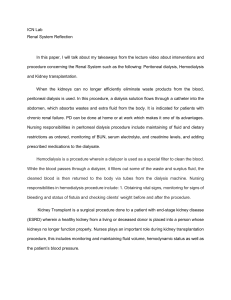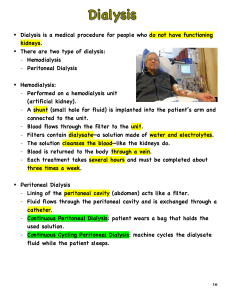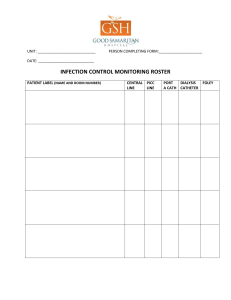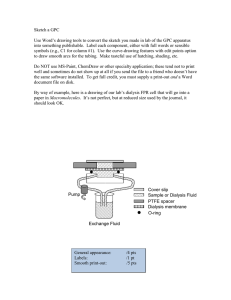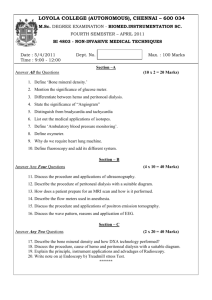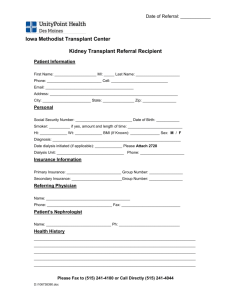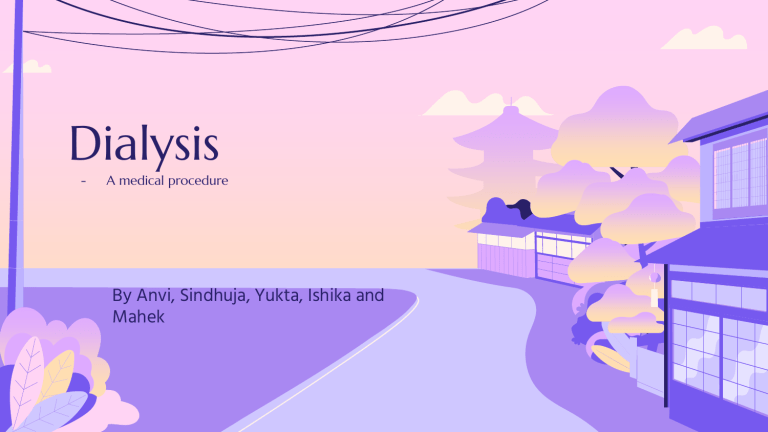
Dialysis - A medical procedure By Anvi, Sindhuja, Yukta, Ishika and Mahek 01. 02. Types of dialysis and Procedure What is Dialysis? 03. Advantages and Disadvantages TABLE OF CONTENTS 01. What is Dialysis? What is Dialysis? Dialysis is a treatment for people whose kidneys are failing. When you have kidney failure, your kidneys don’t filter blood the way they should. As a result, wastes and toxins build up in your bloodstream. Dialysis does the work of your kidneys, removing waste products and excess fluid from the blood. 02. Types of dialysis and their Procedure There are two ways to get dialysis: Hemodialysis and Peritoneal dialysis. With hemodialysis, a machine removes blood from your body, filters it through a dialyzer (artificial kidney) and returns the cleaned blood to your body. This 3- to 5-hour process may take place in a hospital or a dialysis center three times a week. You can also do hemodialysis at home. You may need at-home treatments four to seven times per week for fewer hours each session. You may choose to do home hemodialysis at night while you sleep.During hemodialysis, the dialysis machine: ● ● ● ● Removes blood from a needle in your arm. Circulates the blood through the dialyzer filter, which moves waste into a dialysis solution. This cleansing liquid contains water, salt and other additives. Returns filtered blood to your body through a different needle in your arm. Monitors your blood pressure to adjust how fast blood flows in and out of your body. Types of dialysis With peritoneal dialysis, tiny blood vessels inside the abdominal lining (peritoneum) filter blood through the aid of a dialysis solution. This solution is a type of cleansing liquid that contains water, salt and other additives. During peritoneal dialysis, you: ● ● ● ● ● ● Connect the catheter to one branch of a Y-shaped tube. This tube connects to a bag that has dialysis solution. The solution flows through the tube and catheter into the peritoneal cavity. Disconnect the tube and catheter after about 10 minutes, when the bag is empty. Cap off the catheter. Go about your usual activities while the dialysis solution inside the peritoneal cavity absorbs waste and extra fluids from the body. This process can take 60 to 90 minutes. Remove the cap from the catheter and use the other branch of the Yshaped tube to drain the fluid into a clean, empty bag. Repeat these steps up to four times a day. You sleep with the solution in your stomach all night. Some people prefer to do peritoneal dialysis at night. With automated peritoneal dialysis, a machine called a cycler pumps the fluid in and out of the body while you sleep. 03. Advantages and Disadvantages Advantages and Disadvantages Advantages and disadvantages of peritoneal dialysis Advantages One of the main advantages of PD over hemodialysis is that the procedure can be carried out in the comfort of the patients’ home. For most, all that is required is a washroom with fresh running water, a sterile area of the house for the procedure to take place, and space to store the fluid for dialysis. This also allows patients to travel. For elderly patients who may be unable to administer the procedure themselves, assistance may be given by a trained carer or community nurse. Additionally, the procedure can even be run while the patient sleeps. Disadvantages One of the most significant disadvantages of PD is that it’s required to be carried out every day, which may act as an inconvenience for some. Furthermore, by undergoing PD specifically, there may be a greater risk of developing peritonitis – an infection of the abdomen. In some, quite rare instances, patients may experience scarring and thickening of the peritoneum. In order to prevent this, patients may have to change their treatment to hemodialysis. Additionally, those who undergo PD may report increased fatigue and malnutrition caused by the dialysis fluid, which can lower protein levels. Advantages and Disadvantages Advantages and disadvantages of HaemodylasisAdvantages In comparison to PD, one of the major benefits of hemodialysis is that it enables patients to have four days per week where treatment is required. This arguably can further improve patients’ quality of life by giving them more freedom. Disadvantages In contrast to PD, one of the main disadvantages of hemodialysis is that it often requires patients to go to the hospital three times per week for sessions that last approximately four hours. However, some patients may be able to carry out hemodialysis at home. Furthermore, for patients wanting to travel to a different country, they’d need to locate clinics or hospitals where they can undergo dialysis while away. Additionally, those choosing hemodialysis specifically may face dietary and fluid intake restrictions. Bibliography. http://www.pompanodialysis.com/how-hemodialysis-and-peritoneal-dialysis-work/ https://www.nhs.uk/conditions/dialysis/#:~:text=Dialysis%20is%20a%20procedure%20to,a%20 machine%20to%20be%20cleaned. https://my.clevelandclinic.org/health/treatments/14618-dialysis https://www.kidney.org/atoz/content/dialysisinfo#dialysis-covid-19 https://www.news-medical.net/health/Benefits-and-Disadvantages-of-Dialysis.aspx THANKS! CREDITS: This presentation template was created by Slidesgo, including icons by Flaticon and infographics & images by Freepik
